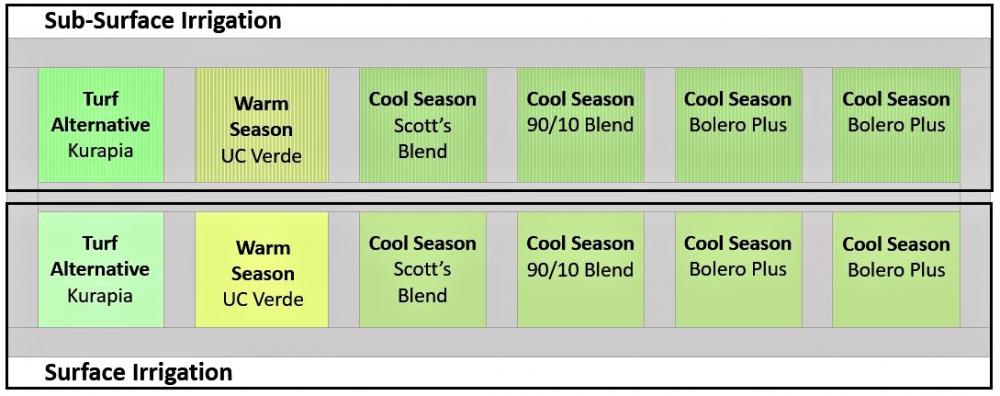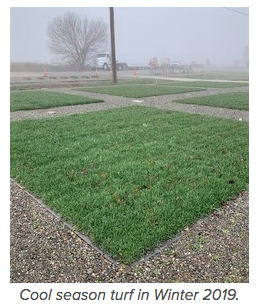Motivation for SmartLawn at UC Davis
In 1993, California adopted a Model Water Efficient Landscape Ordinance (MWELO), which established an annual maximum applied water allowance (MAWA) and a landscape water budget, calculated by estimating the total water use (ETWU) for the landscape area. To meet MWELO, ETWU (gallons) must be less than MAWA (gallons). To calculate ETWU, a plant factor (PF; percentage of reference evapotranspiration) is required for each plant within the landscaped area. UC researchers (Harivandi, et. al. 2009) established the PF is 0.8 or 80% of ET for California cool-season turfgrasses, such as Kentucky blue-grass or fine-leaf fescues, whereas for warm season turfgrass, such as UC Verde, the PF is 0.6 and for a turf alternative, Kurapia®, PF ranges from 0.2 to 0.6 (Harivandi, et. al. 2009; Costello and Jones, 2014; Reid et al. 2015). The SmartLawn demonstration provides irrigation to cool-season, UC Verde, and Kurapia® plots by utilizing smart controller technology and either sub-surface or surface irrigation systems. The amount of applied water is measured by an inline flow meter and compared to ETWU and MAWA for MWELO compliance.
SmartLawn at UC Davis Overview
Located at UC Davis’ Western Center for Agricultural Engineering, the SmartLandscape initiative strives to demonstrate landscape water conservation and water use efficiency leveraging irrigation technology to irrigate low water use plants. SmartLawn, a project of SmartLandscape, aims to demonstrate that sustainable alternatives to traditional turf can look appealing while complying to MWELO. Each SmartLawn plot is 16’ x 16’ and equipped with 3, SoilClik moisture sensors at depths of 3”, 6” and 9”. The soil for the plots was amended, graded, irrigation installed (sub surface Eco-Mat and surface MP rotators) and planted in late spring/early summer of 2020. A Hunter HC-100 inline flow meter was installed in each plot and applied water was measured on a weekly basis.
SmartLawn Plot Demonstration Layout

Turf or Turf Alternative Types and Irrigation Types at SmartLawn
To be in compliance with MWELO, a water budget is required for the landscaped area, and the calculation for ETWU must be less than the calculation for MAWA.
Turf Types and Turf Alternatives at SmartLawn
Turf can be broken into three general categories, outlined below. Click each turf type to learn more and view 2023 water use data.
#1- Cool Season Turf
Cool season turfs such as Bluegrass, Fescue, and Perennial Ryegrass grow well in the cooler temperatures of winter and spring. They maintain their greenness year-round if provided with adequate water during hotter or dryer months. Most traditional turf is composed of cool season grasses. Cool season turfs at SmartLawn include the following blends. Cool season water applied data for 2023 is not yet ready.
- Scott's Miracle Gro Blend (no longer available)
- Delta Bluegrass 90/10 Tall Fescue Blend
- Delta Bluegrass Bolero Plus Blend


#2: Warm Season Turf
Warm season turfs such as Bahiagrass, Bermudagrass, Buffalograss, and Zoysiagrass need high temperatures to perform well. They are generally more water efficient compared to cool season grasses: however, many of them go dormant during the cooler winter months. Click here to view our 2023 UC Verde Buffalograss water applied data.



#3: Turf Alternatives
Turf alternatives cover a broad array of options including mosses, clover, other broadleaf species, and certain ornamental grasses depending on the region. The primary objective of the turf alternatives used at SmartLawn is water conservation. For example, the turf alternative Kurapia can use up to 60% less water compared to traditional cool season turf blends. Click here to view our 2023 Kurapia water applied data.


